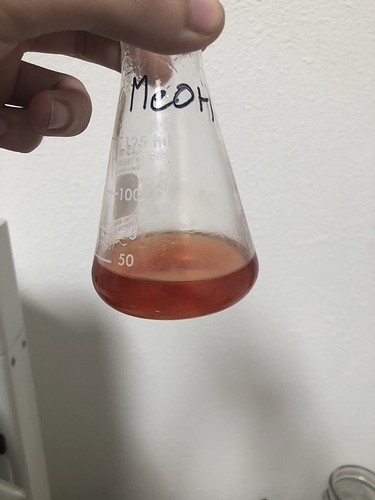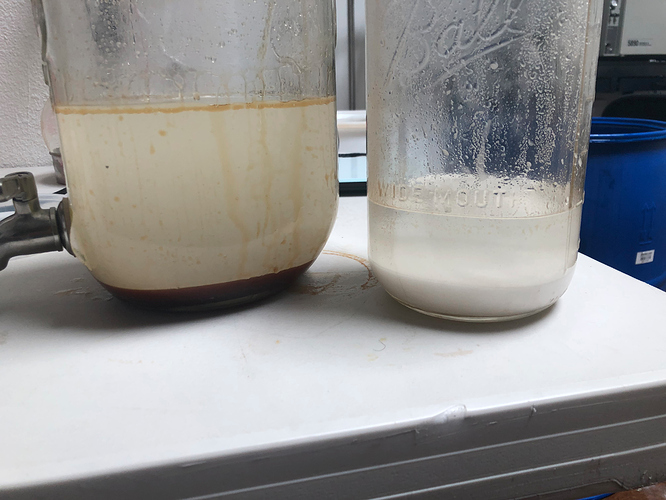I have been having some color problems (yellow distillate turning red after chromo) so I decided to see what was responsible. I left a little bit of starting material in methanol and it turned this reddish color. Does anyone know what is happening?
It could be oxidation from increased surface area when it’s in solvent. was this first pass then dissolved in solvent for chromo?
If this is a cbd extract then your problem is likely related to the ph of your extract after chromatography.
Can you describe your chromatography in more detail? What kind of method are you using?
It is exactly that. That was left overnight but it started shifting colors within an hour of dissolving it. I thought oxidation would take days at least, even in solvents. What in there is oxidizing? Cannabinoids or some other unimportant plant compound?
What you are seeing in the picture is just distillate dissolved in methanol left over night. The method I use results in final product dissolved in a methanol/water mixture which has proven to be difficult to evaporate so we have a lot of it sitting around for a while. It’s clear this is where the discoloration occurs. I want to figure out why methanol does this to see if there is anything I can do to prevent it.
I always see that red color if I redissolve and filter. Not sure what causes it exactly but it comes out in distillation
Cannabinoid solutions change color quickly. Even kept in the freezer it will change. Removing solvent quickly is key
Any suggestions on good ways to do this? The water methanol mixture is such a pain to remove in a rotovap. I have played around with some LLE procedures to transfer the cannabinoids into hexanes but it is also inconvenient.
Thanks @Montroller. Distillation does revert the color change, I was just hoping to not have to include that step.
Welcome to reverse phase chromatography. LLE is the quickest route. Quicker removal, lighter color.
The vast majority of THC-free is super red for this reason.
Just an FYI, with the water involved, using methanol is not advised, your going to have a very hard time getting it below residual limits without excessive time in the vacuum oven if directly rotovapping your fractions
Could I not get the cannabinoids into a hexane layer pretty easily using LLE? Methanol is a pretty large part of some other processes in my lab so I would ideally like to use it.
Yes, like mentioned LLE is the way to go
I’ve experienced darkening of extracts that are mixed in solvents with large concentrations of water added intentionally or unintentionally too. Things that worked for me was trying to limit the time of exposure of the extract to the water/solvent to as short as possible and during long term storage I’d keep it in the dark, sealed, and frozen as cold as possible.
Yeah we are trying that but rotary evaporating the water out is such a pain so it’s bound to sit in solvent for at least a bit. Trying out some LLE at the moment. Thanks for your help.
I had another idea and anyone please chime in if it’s a bad idea.
Maybe you could try absorbing some of the water after chromatography with MgSO4 NaSO4 or molecular sieves.
So I just tried to dissolve some of what we call our “aqueous phase” with some NaSO4. What the aqueous phase is the top layer of water/methanol that separates out of the column fractions if let sit for too long. I took the top layer of the left jar and mixed it with the NaSO4 and the right is the after picture. It is my understanding that mixing methanol and water together results in a clear liquid but if there are cannabinoids in there it will become cloudy, so I am assuming that the NaSO4 removed water and left the methanol and cannabinoids.
What do you think @phenethylamine1
You are right. Methanol and water by themselves should be clear when mixed together. Water and alcohol tends to form emulsions instead of solutions with oils. Lots of microscopic droplets suspended in the liquid makes it look cloudy like that, think like fog or mist (technically aerosols). If NaSO4 does not break your emulsion through desiccation, MgSO4 is a little stronger. You know they are working if they go from a loose powder to a hard solid chunk at the bottom of the jar. Once you have powder that does not chunk up, you’ll know there is no water left to absorb. Patience is key.

